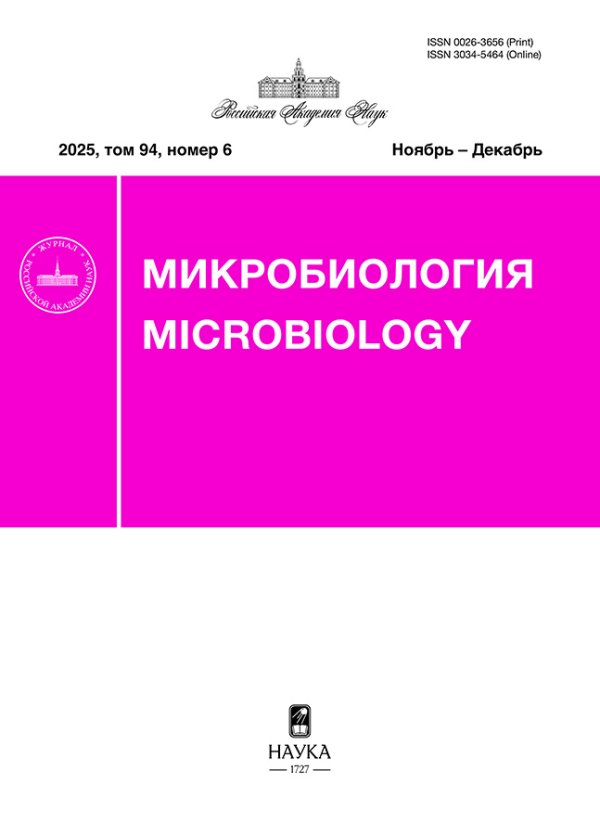Physiological Characteristics of Saccharomyces cerevisiae Strain Overexpressing Polyphosphatase Ppx1
- Authors: Trilisenko L.V.1, Valiakhmetov A.Y.1, Kulakovskaya T.V.1
-
Affiliations:
- Federal Research Center “Pushchino Scientific Center for Biological Research of the Russian Academy of Sciences”, Skryabin Institute of Biochemistry and Physiology of Microorganisms,
- Issue: Vol 92, No 4 (2023)
- Pages: 396-403
- Section: EXPERIMENTAL ARTICLES
- URL: https://journals.rcsi.science/0026-3656/article/view/138211
- DOI: https://doi.org/10.31857/S0026365623600062
- EDN: https://elibrary.ru/RJGLEN
- ID: 138211
Cite item
Full Text
Abstract
Abstract—The Ррх1 exopolyphosphatase of yeast is a constitutive protein localized predominantly in the cytoplasm. The purified enzyme hydrolyzes inorganic polyphosphates with high activity; however, in the knockout ∆ppx1 mutant of Saccharomyces cerevisiae the increase in the polyphosphate level was small, and no changes in physiological properties of this mutant were observed. To elucidate the functions of Ppx1, we studied the physiological characteristics of the S. cerevisiae strain overexpressing this enzyme. When cultivated in the YPD medium, the strain overexpressing Ppx1 showed no growth features different from those of the parental strain. The following physiological features of the strain overexpressing Ppx1 were observed at the stationary stage of growth: the level of ATP increased by nine times, the activity of vacuolar ATPase significantly decreased, and the sensitivity to peroxide increased compared to the parental strain. The level of reactive oxygen species doubled, while the degree of lipid oxidation remained the same as in parental strain. Since overexpression of Ppx1 under the culture conditions used did not affect the polyphosphate level, these polymers were not the regulators of the changes described above. Response to oxidative stress and vacuolar ATPase activity in yeasts is known to be regulated by cAMP, while Ppx1 is capable of hydrolyzing this signaling compound. We suggest that one of the functions of Ppx1 in yeasts is participation in the regulation of cAMP level.
About the authors
L. V. Trilisenko
Federal Research Center “Pushchino Scientific Center for Biological Research of the Russian Academy of Sciences”,Skryabin Institute of Biochemistry and Physiology of Microorganisms,
Email: alla@ibpm.ru
Russia, 142290, Pushchino
A. Ya. Valiakhmetov
Federal Research Center “Pushchino Scientific Center for Biological Research of the Russian Academy of Sciences”,Skryabin Institute of Biochemistry and Physiology of Microorganisms,
Email: alla@ibpm.ru
Russia, 142290, Pushchino
T. V. Kulakovskaya
Federal Research Center “Pushchino Scientific Center for Biological Research of the Russian Academy of Sciences”,Skryabin Institute of Biochemistry and Physiology of Microorganisms,
Author for correspondence.
Email: alla@ibpm.ru
Russia, 142290, Pushchino
References
- Андреева Н.А., Окороков Л.А. Некоторые свойства высокоочищенной полифосфатазы клеточной оболочки дрожжей Saccharomyces cerevisiae // Биохимия. 1990. Т. 55. С. 2286‒2292.
- Andreeva N.A., Okorokov L.A., Kulaev I.S. Purification and certain properties of cell envelope polyphosphatase of the yeast Saccharomyces carlsbergensis // Biochemistry (Moscow). 1990. V. 55. P. 819‒826.
- Калебина Т.С., Егоров С.Н., Арбатский Н.П., Безсонов Е.Е., Горковский А.А., Кулаев И.С. О роли высокомолекулярных полифосфатов в активации глюкантрансферазы Bgl2p из клеточной стенки дрожжей Saccharomyces cerevisiae // ДАН. 2008. Т. 420. С. 695‒699.
- Kalebina T.S., Egorov S.N., Arbatskii N.P., Bezsonov E.E., Gorkovskii A.A., Kulaev I.S. The role of high-molecular-weight polyphosphates in activation of glucan transferase Bgl2p from Saccharomyces cerevisiae cell wall // Dokl. Biochem. Biophys. 2008. V. 420. P. 142‒145.
- Кулаковская Т.В., Трилисенко Л.В., Личко Л.П., Вагабов В.М., Кулаев И.С. Влияние инактивации генов экзополифосфатазы РРХ1 и PPN1 на содержание полифосфатов различных фракций у Saccharomyces cerevis-iae // Микробиология. 2006. Т. 75. С. 35‒39.
- Kulakovskaya T.V., Trilisenko L.V., Lichko L.P., Vagabov V.M., Kulaev I.S. The effect of inactivation of the exo- and endopolyphosphatase genes PPX1 and PPN1 on the level of different polyphosphates in the yeast Saccharomyces cerevisiae // Microbiology (Moscow). 2006. V. 75. P. 25–28.
- Личко Л.П., Кулаковская Т.В., Кулаковская Е.В., Кулаев И.С. Инактивация генов PPX1 и PPN1, кодирующих экзополифосфатазы дрожжей Saccharomyces cerevisiae не препятствует использованию полифосфатов в качестве фосфорных резервов // Биохимия. 2008. Т. 73. С. 1224‒1229.
- Lichko L.P., Kulakovskaya T.V., Kulakovskaya E.V., Kulaev I.S. Inactivation of PPX1 and PPN1 genes encoding exopolyphosphatases of Saccharomyces cerevisiae does not prevent utilization of polyphosphates as phosphate reserve // Biochemistry (Moscow). 2008. V. 73. P. 985–989.
- Личко Л.П., Эльдаров М.А., Думина М.В., Кулаковская Т.В. Сверхэкспрессия гена PPX1 не влияет на полифосфаты Saccharomyces cerevisiae // Биохимия. 2014. Т. 79. С. 1487–1492.
- Lichko L.P., Eldarov M.A., Dumina M.V., Kulakovskaya T.V. PPX1 gene overexpression has no influence on polyphosphates in Saccharomyces cerevisiae // Biochemistry (Moscow). 2014. V. 79. P. 1211–1215.
- Ahmed Y., Ikeh M.A.C., MacCallum D.M., Day A.M., Waldron K., Quinn J. Blocking polyphosphate mobilization inhibits pho4 activation and virulence in the pathogen Candida albicans // mBio. 2022. V. 13. Art. e0034222. https://doi.org/10.1128/mbio.00342-22
- Andreeva N., Ledova L., Ryazanova L., Tomashevsky A., Kulakovskaya T., Eldarov M. Ppn2 endopolyphosphatase overexpressed in Saccharomyces cerevisiae: comparison with Ppn1, Ppx1, and Ddp1 polyphosphatases // Biochimie. 2019. V. 163. P. 101‒107.
- Bond S., Forgac M. The Ras/cAMP/protein kinase A pathway regulates glucose-dependent assembly of the vacuolar (H+)-ATPase in yeast // J. Biol. Chem. 2008. V. 283. P. 36 513‒36 521.
- Borst-Pauwels G.W., Peters P.H. Factors affecting the inhibition of yeast plasma membrane ATPase by vanadate // Biochim. Biophys. Acta. 1981. V. 642. P. 173‒181.
- Bowman E.J., Siebers A., Altendorf K. Bafilomycins: a class of inhibitors of membrane ATPases from microorganisms, animal cells, and plant cells // Proc. Natl. Acad. Sci. USA. 1988. V. 85. P. 7972‒7976.
- Harris D.A. Azide as a probe of co-operative interactions in the mitochondrial F1-ATPase // Biochim. Biophys. Acta. 1989. V. 974. P. 156‒162.
- Heinonen J.K., Lahti R.J. A new and convenient colorimetric determination of inorganic orthophosphate and its application to the assay of inorganic pyrophosphatase // Anal. Biochem. 1981. V. 113. P. 313‒317.
- Gerasimaitė R., Sharma S., Desfougères Y., Schmidt A., Mayer A. Coupled synthesis and translocation restrains polyphosphate to acidocalcisome-like vacuoles and prevents its toxicity // J. Cell. Sci. 2014. V. 127. P. 5093‒5104.
- Jakubowski H. Sporulation of the yeast Saccharomyces cerevisiae is accompanied by synthesis of adenosine 5'-tetraphosphate and adenosine 5'-pentaphosphate // Proc. Natl. Acad. Sci. USA. 1986. V. 83. P. 2378‒2382.
- Jin R., Dobry C.J., McCown P.J., Kumar A. Large-scale analysis of yeast filamentous growth by systematic gene disruption and overexpression // Mol. Biol. Cell. 2008. V. 19. P. 284‒296.
- Khan M.M., Lee S., Couoh-Cardel S., Oot R.A., Kim H., Wilkens S., Roh S.H. Oxidative stress protein Oxr1 promotes V-ATPase holoenzyme disassembly in catalytic activity-independent manner // EMBO J. 2022. V. 41. Art. e109360. https://doi.org/10.15252/embj.2021109360
- Kulaev I.S., Vagabov V.M. Polyphosphate metabolism in microorganisms // Adv. Microbiol. Physiol. 1983. V. 24. P. 83‒171.
- Kulakovskaya T. Inorganic polyphosphates and heavy metal resistance in microorganisms // World J. Microbiol. Biotechnol. 2018. V. 34. Art. 139. https://doi.org/10.1007/s11274-018-2523-7
- Lichko L., Kulakovskaya T., Pestov N., Kulaev I. Inorganic polyphosphates and exopolyphosphatases in cell compartments of the yeast Saccharomyces cerevisiae under inactivation of PPX1 and PPN1 genes // Biosci. Rep. 2006. V. 26. P. 45‒54.
- Lonetti A., Szijgyarto Z., Bosch D., Loss O., Azevedo C., Saiardi A. Identification of an evolutionarily conserved family of inorganic polyphosphate endopolyphosphatases // J. B-iol. Chem. 2011. V. 286. P. 31966‒31974.
- McCarthy L., Abramchuk I., Wafy G., Denoncourt A., Lavallée-Adam M., Downey M. Ddp1 cooperates with Ppx1 to counter a stress response initiated by nonvacuolar polyphosphate // mBio. 2022. V. 13. Art. e0039022. https://doi.org/10.1128/mbio.00390-22
- Miozzari G.F., Niederberger P., Hutter R. Permeabilization of microorganisms by Triton X-100 // Anal. Biochem. 1978. V. 90. P. 220‒233.
- Parra K.J., Chan C.Y., Chen J. Saccharomyces cerevisiae vacuolar H+-ATPase regulation by disassembly and reassembly: one structure and multiple signals // Eukaryot. Cell. 2014. V. 13. P. 706‒714.
- Portela P., Rossi S. cAMP-PKA signal transduction specificity in Saccharomyces cerevisiae // Curr. Genet. 2020. V. 66. P. 1093‒1099. https://doi.org/10.1007/s00294-020-01107-6
- Roger F., Picazo C., Reiter W., Libiad M., Asami C., Hanzén S., Gao C., Lagniel G., Welkenhuysen N., Labarre J., Nyström T., Grotli M., Hartl M., Toledano M.B., Molin M. Peroxiredoxin promotes longevity and H2O2-resistance in yeast through redox-modulation of protein kinase A // Elife. 2020. V. 9. Art. e60346. https://doi.org/10.7554/eLife.60346
- Sethuraman A., Rao N.N., Kornberg A. The endopolyphosphatase gene: essential in Saccharomyces cerevisiae // Proc. Natl. Acad. Sci. USA. 2001. V. 98. P. 8542–8547.
- Tammenkoski M., MoiseevV.M., Lahti M., Ugochukwu E., Brondijk T.H.C., White S.A., Lahti R., Baykov A.A. Kinetic and mutational analyses of the major cytosolic exopolyphosphatase from Saccharomyces cerevisiae // J. Biol. Chem. 2007. V. 282. P. 9302‒9311.
- Tammenkoski M., Koivula K., Cusanelli E., Zollo M., Steegborn C., Baykov A.A., Lahti R. Human metastasis regulator protein H-prune is a short-chain exopolyphosphatase // Biochemistry. 2008. V. 47. P. 9707‒9713.
- Ugochukwu E., Lovering A.L., Mather O.C., Young T.W., White S.A. The crystal structure of the cytosolic exopolyphosphatase from Saccharomyces cerevisiae reveals the basis for substrate specificity // J. Mol. Biol. 2007. V. 371. P. 1007‒1021.
- Wurst H., Shiba T., Kornberg A. The gene for a major exopolyphosphatase of Saccharomyces cerevisiae // J. Bacteriol. 1995. V. 177. P. 898‒906.
Supplementary files















